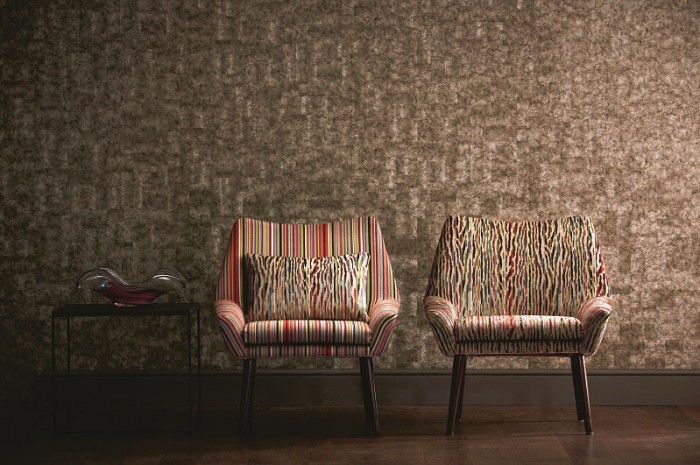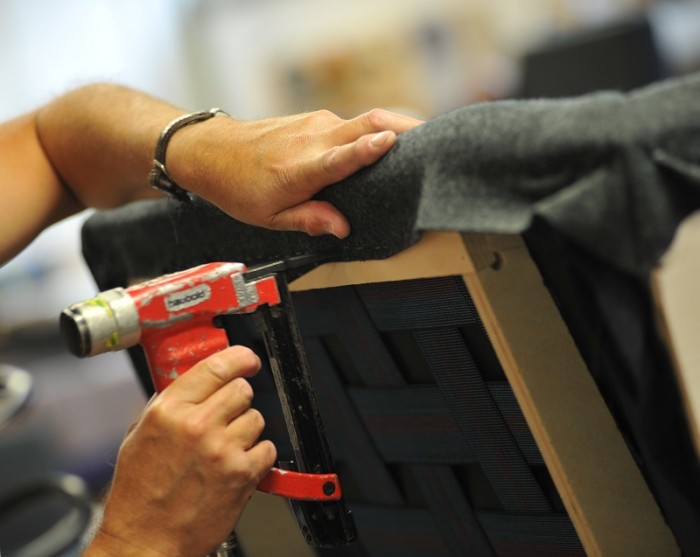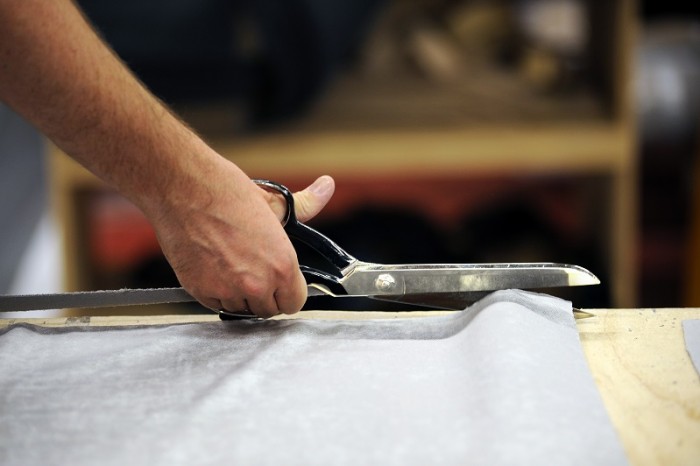Q&A Session with Alys Bryan
 We caught up with furniture designer Alys Bryan who has had nearly 10 years’ experience of working in the contract sector. She used the recent industry events (Focus15, Decorex & the London Design Festival) as an opportunity to talk to BCFA members about contract upholstery fabrics. We caught up with her to ask what she had discovered
We caught up with furniture designer Alys Bryan who has had nearly 10 years’ experience of working in the contract sector. She used the recent industry events (Focus15, Decorex & the London Design Festival) as an opportunity to talk to BCFA members about contract upholstery fabrics. We caught up with her to ask what she had discovered
What was your starting point when you met our members?
As a designer, my first instinct was to discuss the availability of textile designs for the contract sector. In the past, textile sales reps regularly presented their new collections, only to tell me that several of the most exciting designs did not meet the UK’s strict fire requirements or contract specification rub count for upholstery. I speak frequently with interior designers, and this is an issue with which they are, unfortunately, all too familiar. However, after my conversations with BCFA members, I can confidently say that the textile industry increasingly recognises the importance of launching contract specification fabric collections.
I found that textile brands who have not traditionally focused on supplying the contract sector can now see the benefits of cross sector sales, especially as many designers and specifiers also work across multiple sectors. Textile brands such as GP&J Baker have ensured that 100% of their 2015 upholstery collections achieve contract specification. Contract specific textile brands have looked outside workplace and hospitality settings and have developed expertise in fulfilling healthcare, education and transportation requirements.
Kate Long, Director of Rethink Interiors, applauded the contract textile brands for working with designers like herself in the development of their textile collections. Kate has found that textile brands request feedback on their designs and listen to her opinions, which has built the specifier and supplier relationship, allowed for thoroughly resolved designs, colour palettes with longevity and also provided the possibility for low volume bespoke orders.
Do the domestic and contract design trends run in parallel?
When I discussed the issue of design trends in the contract sector textile brands, furniture manufacturers and specifiers all explained that society’s raised design awareness has increased the demand for design led products. Domestic customers are influenced by their hospitality experiences as a key form of inspiration for their own homes, however, the design for luxury hospitality is increasingly influenced by trends in high end residential design.
I can see that just as the furniture industry has seen working practices evolve and the requirements for workplace and hospitality furniture converge, the design trends for domestic and hospitality textiles have blended, resulting in the emergence of increasingly exciting textile designs for the contract sector.
Can you outline the fabric requirements for contract furniture specification?
The current requirements are that contract upholstery textiles must meet BS 5852 Part 2 Ignition Source 5 (Crib 5) and achieve a minimum of 40,000 Martindale rubs.
I define fabrics which meet contract requirements as those which are either inherently BS 5852 Part 2 Ignition Source 5 (Crib 5) or those which are able to be treated to meet BS 5852 Part 2 Ignition Source 5 (Crib 5) and achieve a minimum of 40,000 Martindale rubs.
Do specifiers continue to rely on a library of fabric books?
Yes, many do. Fabric books are vital for assessing the look and feel of the fabrics, they also provide vital information on the composition of the fabric; they also provide vital information on the composition of the fabric, its suitability for use and its rub count. I have been frustrated in the past when the BS 5852 Part 2 Ignition Source 5 (Crib 5) or suitability for back coating has not been stated and have discussed this matter with BCFA members. Contract focused textile brands ensure their fabric is fully tested prior to launch; this enables full information, including contract standard fire safety results to be printed within the fabric books. I spoke with a non-BCFA member and was interested that they felt unable to prioritise this; providing full information at the initial selection stage further prevents failure at the procurement stage.
I would like to add how impressed I have been by the industry’s commitment to testing, including the rigorous due-diligence testing which I discussed with Carolyn Mitchell, Group Contracts Sales Director at Walker Greenbank PLC.
When I discussed fabric books with Robert Stone at Lelievre (UK), he explained that they have recently reviewed their longstanding ‘Contract’ collections, by renaming them ‘Collections’; they now cater to the contract sector, whilst also making the designs inclusive of domestic customers.
Are specifiers also supported by online services?
Not all specifiers are able to access a thorough fabric book library; as a freelance designer I often rely on online technical information prior to ordering samples. I spoke to many BCFA members, who confirmed the importance of their online services, several have recently invested heavily in their website including trade specific areas. In addition, they explained the importance of providing a personal service to their often traditional customers. Building strong relationships with customers through employing and training knowledgeable customer service staff and project management personnel is fundamental.
Did you encounter any criticism of the textile brands?
The issue of supply chain was raised by one BCFA member; as a manufacturer they feel that the current supply chain is inefficient. Although they are pleased with a greater diversity of designs on offer, they feel that this exacerbates issues of low stock and long lead times. I put this issue to several of the textile brands I spoke with; all explained that this was an infrequent problem but went on to explain how they are tackling it. It was suggested that increased communication and project transparency between specifier, fabric supplier and manufacturer would create a smoother supply chain, but I was especially impressed with how fabric manufacturer Camira have invested into the roots of their supply chain. By holding the control over almost every aspect of their manufacturing process, Camira are able to work to impressive 98% service level.
The issue of the disposal of textile remnants was raised by a BCFA member furniture manufacturer, alongside many other important environmental issues within the contract textile industry, which I will discuss in a separate post – If you would like to contribute to this article please contact alys@alysbryan.co.uk
What do you see as the future challenges for the contract fabric market?
It has been fantastic to learn how fabric brands have focused on cross sector selling and in sector diversification, resulting in a wider variety of high quality design-led textile collections. It is extremely encouraging to hear how these brands have been working with expert designers and specifiers to develop their designs.
It has also been exciting to hear how textile brands are investing in their online services as well as in the control of their supply chain. A continuous area of development for textile brands is the exploration of new technology and how these capabilities can be used for both textile design and manufacture. I am very much looking forward to seeing how new technology will be utilised and how these developments will impact the contract sector.
I would like to thank all the BCFA members who gave their time to discuss their business with me for this article. Thank you to GP&J Baker, Rethink Interiors, Walker Greenbank, Lelievre, Camira, Création Bauman, Vescom, Morgan, Andrew Muirhead, Lyndon, FIRA.
I welcome you to continue this conversation; please leave your comment or question below…









